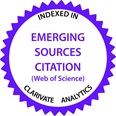Tytuł
Wpływ oceny pracowniczej na wyniki przedsiębiorstwa – mediacyjna rola rezultatów ZZL przy nowatorskim zastosowaniu wskaźnika efektywności
ORCID
Marzena Stor: 0000-0002-3744-791X
Keywords
employee performance appraisal, MNC, HRM, performance, finance, innovativeness, quality
Słowa kluczowe
ocena pracownicza,przedsiębiorstwo międzynarodowe,ZZL,wyniki przedsiębiorstwa,finanse,innowacyjność,jakość
Abstract
Purpose: The main goal of the article, identified with the main research problem, is to determine the mediating role of HRM outcomes in the relationships between employee performance appraisal (EPA) and company performance results and to establish whether there are any identifiable regularities in this scope in four specific contexts, i.e. the pre-pandemic and pandemic periods of COVID-19 in the HQs and foreign subsidiaries of MNCs. Design/methodology/approach: The empirical research included 200 MNCs headquartered in Central Europe. To capture the actual relations between the variables under study, the raw data in the variables were adjusted with the efficiency index (EI), which is a novelty in this type of research. The Partial Least Squares Structural Equation Modeling (PLS-SEM) was used to verify the research hypotheses and assess the mediating effects. Findings: EPA had a positive effect on results in HRM, finance, innovativeness and quality, both in the pre-pandemic and pandemic periods, although this effect was not always statistically significant. Furthermore, the company’s performance results in HRM mediate positively the relationships between EPA and the other three categories of company performance results, regardless of the organizational level (HQs’ or subsidiaries’) and time period under consideration. Additionally, during the pandemic, the company’s performance results in HRM mediate the relationships between EPA and the company’s performance results in innovativeness stronger than in the pre-pandemic time, both at the HQs and local subsidiaries. This suggests that the EPA used such solutions in conjunction with other HRM subfunctions that stimulated entrepreneurial, creative and innovative behavior of employees in such a way that organizations could achieve better innovation results during the crisis than before it. Research limitations/implications: The study has some limitations, including the research sample’s structure, not fully representing the general population. Only HQs respondents were asked about performance results in foreign subsidiaries, excluding local informants. The qualitative benchmarking method used is problematic, relying on comparisons instead of objective measures. Furthermore, the analysis did not consider potential differences in economic, legal, or social conditions among the various countries where foreign subsidiaries were located. Originality/value: In addition to confirming the results of some other studies, the article also provides new knowledge. It determines the mediating role of HRM outcomes in the relationship between EPA and company performance results in finance, innovativeness, and quality. Moreover, it identifies certain regularities in the four studied contexts, which is a novelty in this type of research. It also uses an innovative approach to including employee KPIs as the efficiency index in analyzing the relationships between the variables under study.
Abstrakt
Cel: głównym celem artykułu, utożsamianym z głównym problemem badawczym, jest określenie mediacyjnej roli rezultatów ZZL w relacjach między oceną pracowniczą (OP) a wynikami przedsiębiorstwa oraz ustalenie czy występują w tym zakresie identyfikowalne prawidłowości w czterech specyficznych kontekstach, tj. w okresie przedpandemicznym i pandemicznym COVID-19 oraz w centralach i jednostkach przedsiębiorstw międzynarodowych. Metodologia: badanie empiryczne objęło 200 przedsiębiorstw międzynarodowych z siedzibą w Europie Środkowej. Aby uchwycić faktyczne relacje między badanymi zmiennymi, surowe dane w zmiennych skorygowano o wskaźnik efektywności (EI), który jest nowością w tego typu badaniach. Do weryfikacji hipotez badawczych i oceny efektów pośredniczących wykorzystano modelowanie równań strukturalnych metodą cząstkowych najmniejszych kwadratów (PLS-SEM). Wyniki: OP pozytywnie wpłynęła na wyniki w zakresie ZZL, finansów, innowacyjności i jakości, zarówno w okresie przedpandemicznym, jak i pandemicznym, choć efekt ten nie zawsze był istotny statystycznie. Co więcej, wyniki firmy w zakresie ZZL pozytywnie pośredniczą w relacjach między OP a pozostałymi trzema kategoriami wyników przedsiębiorstwa, niezależnie od poziomu organizacyjnego (centrali lub jednostki zagranicznej) i rozważanego okresu czasu. Dodatkowo w czasie pandemii wyniki w ZZL pośredniczą w relacjach między OP a wynikami przedsiębiorstwa w innowacyjności silniejszej niż przed pandemią, zarówno w centrali, jak i jednostkach zagranicznych. Sugeruje to, że w OP stosowano takie rozwiązania w połączeniu z innymi subfunkcjami ZZL, które stymulowały przedsiębiorcze, kreatywne i innowacyjne zachowania pracowników w taki sposób, że organizacje mogły osiągać lepsze wyniki innowacyjne w czasie kryzysu niż przed nim. Ograniczenia/implikacje badawcze: badanie ma pewne ograniczenia, w tym strukturę próby badawczej, która nie w pełni reprezentuje populację ogólną. Tylko respondenci centrali zostali zapytani o wyniki w zagranicznych spółkach zależnych, z wyłączeniem lokalnych informatorów. Zastosowana jakościowa metoda benchmarkingu opiera się na porównaniach, a nie na obiektywnych pomiarach. Ponadto w analizie nie uwzględniono potencjalnych różnic w warunkach ekonomicznych, prawnych czy społecznych pomiędzy różnymi krajami, w których zlokalizowane były jednostki zagraniczne. Oryginalność/wartość: oprócz potwierdzenia wyników kilku innych badań, artykuł dostarcza również nowej wiedzy. Określa pośredniczącą rolę wyników ZZL w relacji między OP a wynikami organizacji w zakresie finansów, innowacyjności i jakości. Ponadto identyfikuje pewne prawidłowości w czterech badanych kontekstach, co jest nowością w tego typu badaniach. Wykorzystuje również nowatorskie podejście do uwzględnienia KPI pracowników jako wskaźnika efektywności w analizie zależności pomiędzy badanymi zmiennymi.
Acknowledgments
Funding
The project was financed by the Ministry of Education and Science in Poland under the program “Regional Initiative of Excellence” 2019–2023. Project number: 015/RID/2018/19.
Recommended Citation
Stor, M. (2023). The Effects of Employee Performance Appraisal on the Company Performance Results: The Mediating Role of HRM Outcomes With an Innovative Application of the Efficiency Index. European Management Studies, 21(1), 68-99. https://doi.org/10.7172/1644-9584.99.4
First Page
68
Last Page
99
Page Count
31
DOI
10.7172/1644-9584.99.4
Publisher
University of Warsaw







